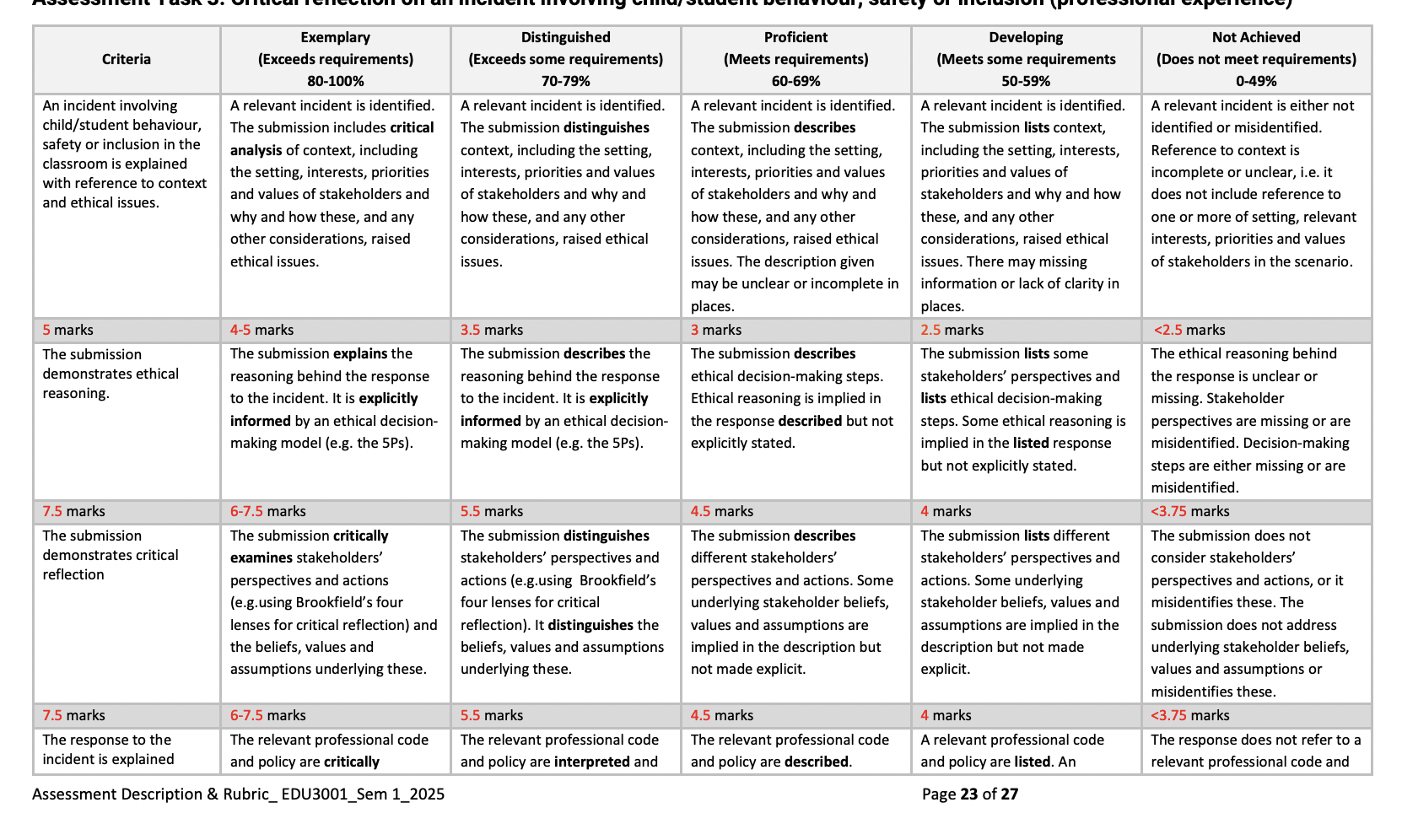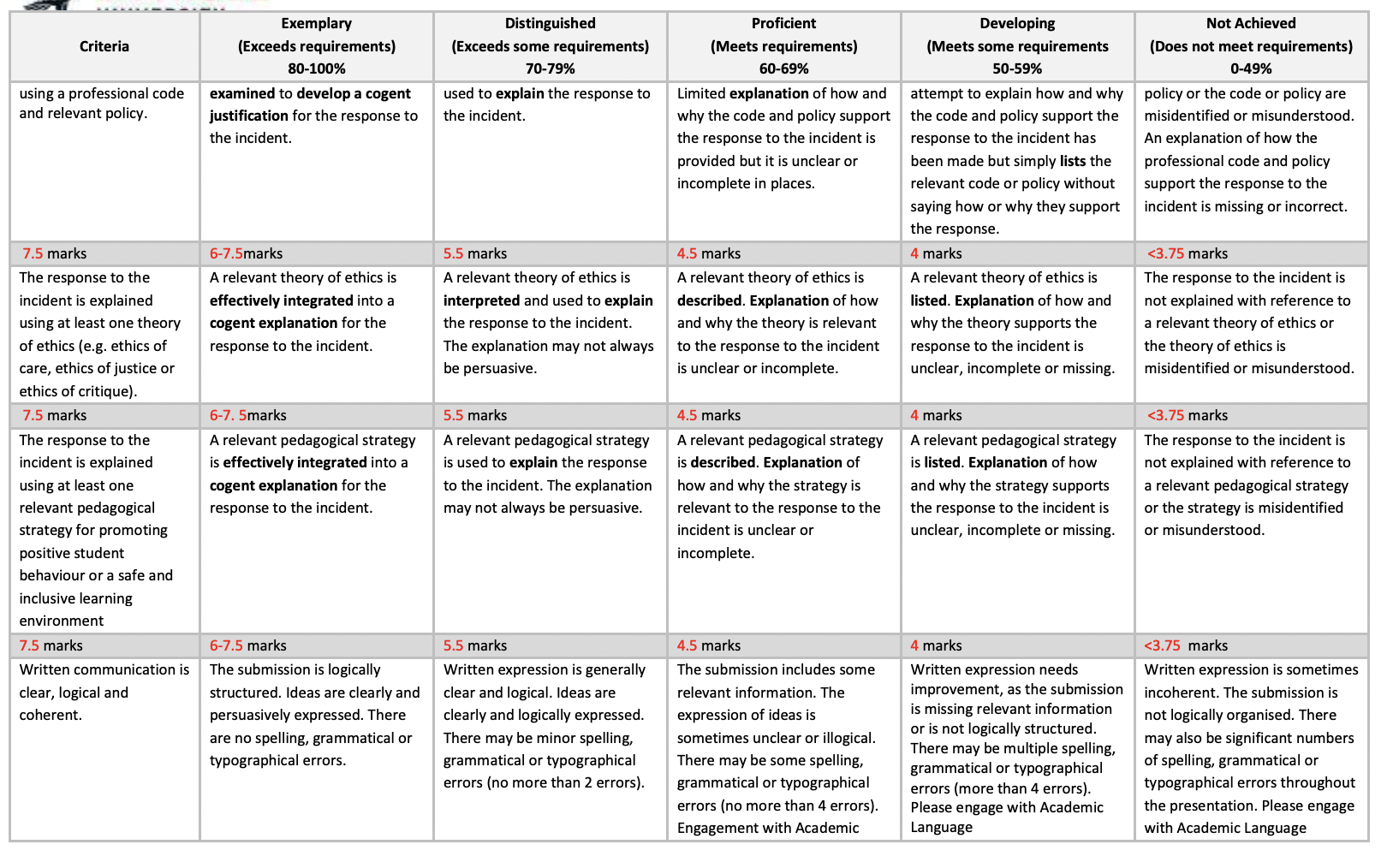Ethical Practice and Professional Reflection in Education EDU4025
- Subject Code :
EDU4025
Critical reflection on an incident involving child/student behaviour, safety or inclusion (professional experience)
Purpose
Use critical reflection skills to analyse the ethical implications of an incident that you personally experienced during professional experience and how you responded to that incident. This will enable you to demonstrate essential professional skills of ethical reasoning and ethical decision-making around your own practice in a professional context.
Task details
In this assessment you will critically reflect on an incident that involved student behaviour, safety or inclusion in the classroom or early childhood setting. This must be an incident that arose for you personally during your placement, not simply something that you observed. The incident will most likely involve your interaction with a student, but it could also relate to an interaction with a teacher, school leader, parent or carer, or perhaps a combination of these. In your submission you will critically reflect on the incident, noting any ethical issues that arose for you during the incident. You will explain your response to the incident using professional ethics, including a professional code, relevant policy, at least one theory of ethics and one relevant pedagogical strategy for promoting positive student behaviour and/or a safe and inclusive learning environment. You will conclude your reflection with an ethical position on how you would respond to a similar incident in future.
Base it on Year 3 students
Your written submission of 2000 words should respond to the following questions:
- What happened?
Without providing any identifying information (e.g. school or kindergarten, names of individuals), briefly explain who was involved, what happened, including what the parties said or did, when and where the incident happened. Describe your professional relationship with the other party/ies involved in the incident.
- Did any ethical issues arise for you during the incident?
Think about the context for the incident, including the setting and the different interests, priorities and values of those involved.
Explain why and how any of these, and any other considerations, raised an ethical issue for you.
- What was your reaction to the incident?
What did you say or do to respond to the incident?
Were any further steps or follow-up action identified?
- How would you explain your response to the incident using at least one relevant professional code?
Refer to a professional code that provide guidance for managing professional relationships in education e.g. VIT Code of Ethics, VIT Code of Conduct, Early Childhood Australia Code of Ethics. Does that professional code support the way that you responded during the incident? Why or why not?
- How would you explain your response to the incident using policy?
Refer to relevant school or kindergarten policy, e.g. school-wide positive behaviour support system, behaviour management policy, conflict resolution policy, anti-bullying policy, diversity & inclusion policy, child safety and welbeing policy, privacy policy, digital devices policy etc.
Does this policy support the way that you responded during the incident? Why or why not?
- How would you explain your response to the incident using a theory of ethics?
How are an ethics of care, ethics of justice, ethics of critique, or a combination of these, relevant to your response? Does the theory of ethics that you chose support the way that you responded to the incident? Why or why not?
- How would you explain your response using at least one relevant pedagogical strategy for promoting positive student relationships, classroom norms and expectations, procedures, cultural relevance and sensitivity and student empowerment
For example, did you refer to norms and expectations (including classroom/kindergarten rules)? Did you use established classroom procedures (e.g. verbal and non-verbal cues)? Did you use an inclusive pedagogy such as critical pedagogy, culturally relevant/culturally inclusive pedagogy? Did you show high expectations and/or model the desired behaviour?
- How would you respond to a similar incident in the future?
With the benefit of hindsight, how would you respond to a similar incident in future? Why?
Suggested structure
Your submission should include:
An introduction in which you provide a brief overview of the scope and focus of your reflection (approximately 200 words)
A brief recount of the incident (approximately 200 words)
Critical analysis of the incident (approximately 500 words), including discussion of:
o the ethical issues you identified
o your response and if/how it was shaped by those ethical issues
Critical reflection on your response to the incident (approximately 600 words), including an explanation of your response using:
o A professional code
o Relevant policy
o At least one theory of ethics
o At least one pedagogical strategy for promoting positive student relationships, classroom norms and expectations, procedures, cultural relevance and sensitivity and student empowerment.
An ethical position on how you would respond to a similar ethical dilemma in future, and why. (approximately 300 words)
A conclusion : Summary of key points (nothing new) (approximately 200 words).
Other points to note
- Generative AI (e.g. Chat GPT) must not be used to complete this assessment. This assessment has been designed to enable you to demonstrate ethical reasoning and a personal professional ethics that is directly linked to professional experience.
- While this is a personal reflection, written communication is different from spoken communication and should be more formal.
Journalistic language such as 'In this day and age' should not be used. - A Table of Contents and Abstract are not required.
- Headings may be used to signpost content. Other topic-specific subheadings can be used if they improve readability.
- Make sure that the topic of each paragraph is clear.
- All the points you make should be supported with a relevant source. Appropriate sources are peer-reviewed journal articles, text books, and chapters in text books. Blogposts should be avoided unless the information cannot be found elsewhere. The same applies to lectures or lecturer comments.
- It is expected that your submission will cite prescribed references we have used in the subject, as well as other materials you locate through your own research and use of library sources.
Assessment criteria
Your submission will be assessed against the following criteria. Please also refer to the rubric provided as part of the resources for completing this assessment.
- An incident involving child/student behaviour, safety or inclusion is explained with reference to context and ethical issues. (10%)
- The submission demonstrates ethical reasoning. (15%)
- The submission demonstrates critical reflection (15%)
- The response to the incident is explained using a professional code and relevant policy. (15%)
- The response to the incident is explained using at least one theory of ethics (e.g. ethics of care, ethics of justice or ethics of critique). (15%).
- The response to the incident is explained using at least one relevant pedagogical strategy for promoting positive student behaviour or a safe and inclusive learning environment (15%)
- Written communication is clear, logical and coherent. (10%)
- APA7 referencing style is accurately and consistently used. (5%)
Please also use the below references
Codes of Conduct and Ethics | Victorian Institute of Teaching : Webpage
ECA Code of Ethics Webpage by Early Childhood Australia (2016)
Chapter 5: An ethics of care in Moral boundaries: a political argument for an ethic of care Chapter by Joan C. Tronto (1993)
Chapter 1: Engaged Pedagogy in Teaching to transgress: education as the practice of freedom Chapter
Duty of Care: Policy Webpage (2020)
Chapter 1: Engaging Critical Pedagogy in Education : Global Phenomenon, Local Praxis Chapter by Fida Sanjakdar Michael W Apple
Parent involvement in positive behaviour intervention and supports in Australia: teacher and parent/caregiver perspectives in The Australian Educational Researcher Article by Rose, Michelle
Selected pages from chapter 6 in Positive learning environments: establishing & sustaining productive classrooms Chapter by John De Nobile
Chapter 15: Educational ethics to support good teaching in diversity in Teacher Ethics and Teaching Quality in Scandinavian Schools: New Reflections, Future Challenges, and Global Impacts Chapter
The Code of Conduct support pack | Victorian Institute of Teaching Webpage
Chapter 4: Justice, Utility, and Care in The Ethics of Care Chapter by Virginia Held
Rubric




